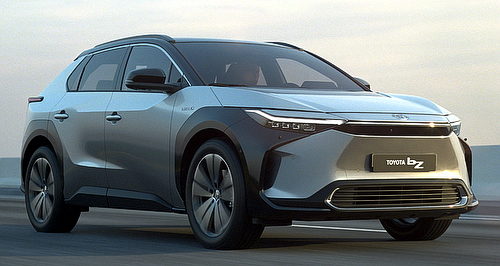Future models - Toyota - BZ4XAll-electric bZ4X SUV to deliver 500km rangeSIZE MATTERS: It might look like a C-HR, but the new bZ4X EV is larger than a RAV4. Toyota’s first mass-produced EV to take on Hyundai Ioniq 5 and Tesla Model Y1 Nov 2021 By MATT BROGAN TOYOTA has debuted the production version of its first mass-produced electric car, the bZ4X SUV. Similar in its styling to the Toyota C-HR but slotting between the RAV4 and Kluger in terms of its size, the bZ4X will compete with rivals that include the Hyundai Ioniq 5 (from $71,900) and Telsa Model Y (TBC).
The Toyota bZ4X is the first of seven models Toyota plans to release under its Beyond Zero (bZ) sub-brand and the first to be developed from the Japanese brand’s modular battery-electric vehicle architecture dubbed e-TNGA. Toyota said previously that it plans to launch no fewer than 15 all-electric models by 2025.
Set to launch in international markets from mid 2022, the bZ4X will be offered in both front- and all-wheel drive configurations promising driving range of 460km and 500km respectively according to the Japanese WLTC test cycle.
Toyota says it is able to maintain driving range in even the coldest temperatures courtesy of an onboard heat pump, the bZ4X also featuring one-pedal driving technology (similar to that of the Nissan LEAF) and regenerative braking capabilities.
Fast charging (150kW DC) provides up to 80 per cent capacity in approximately 30 minutes while the on-board charger (6.6kW AC) will likely provide overnight recharging from a domestic outlet. Vehicle to load (V2L) capabilities are also offered, allowing the bZ4X to power external appliances.
Single-motor front-wheel drive variants output 150kW/265Nm and are powered by a 71.4kWh lithium-ion battery. Acceleration to 100km/h is said to take 8.4 seconds while top speed is listed at 160km/h. Dual-motor all-wheel drive models offer combined output of 160kW/336Nm and hit triple digits in 7.7 seconds, but retain the two-wheel drive model’s 160km/h v-max.
The Toyota bZ4X measures 4690mm in length, is 1860mm wide, 1650mm high, and rides on a 2850mm wheelbase. The proportions are said to give the all-electric SUV similar cabin space to the Camry sedan, and as much as 452 litres of cargo space (in five-seat mode and to window height).
The new-age interior – replete with optional yoke-style steering wheel and steer-by-wire technology – incorporates a large 12.0-inch infotainment screen with Apple CarPlay and Android Auto connectivity, and satellite navigation. A smaller 7.0-inch dashboard display offers further driver-oriented details including speed, charging status, remaining range, and driving mode information.
Recalling Toyota’s history as a loom manufacturer, the woven upholstery provides what the brand says is the “ambience of a living room, while the optional panoramic solar sunroof can contribute enough charge to provide up to 1800km of driving range to the bR4X each year.
The bR4X features LED lighting front and rear and rides on alloy wheels ranging in size to 20 inches in diameter. The model also incorporates the complete range of Toyota Safety Suite driver assistance and safety technologies including radar and camera-based alert and recognition systems and remote parking technology.
Toyota will release the bZ4X in selected international markets from mid-2022 with Australia likely to see the model in local showrooms from the end of next year. Speaking to GoAuto earlier this year, Toyota Australia vice-president of sales and marketing Sean Hanley said the model is expected to carry a hefty price tag, similar to that of the Hyundai Ioniq 5.
“We’ll introduce the bZ4X as soon as possible after the global launch which is targeted for around mid-2022,” Mr Hanley said.
“Pricing will be announced closer to introduction, but this car will be expensive, as was the original Prius that we launched back in October 2001, and this is due to significant research and development cost recovery.
“Like hybrids, battery-electric vehicle adoption and affordability will take time, but certainly not 20 years. They will eventually become a sustainable means of technology, but the energy mix, battery technology and infrastructure are still being developed,” he concluded.  Read more21st of September 2021  Ioniq 5 EV priced from $71,900 + ORCHyundai beats Kia EV6 to Australia with limited first batch of electric Ioniq 5 SUVsAll future models Alfa Romeo Alfa Romeo Abarth Abarth Audi Audi Aston Martin Aston Martin BMW BMW Bentley Bentley Chrysler Chrysler Chevrolet Chevrolet Dodge Dodge Citroen Citroen Ferrari Ferrari DS DS Ford Ford Fiat Fiat FPV FPV Foton Foton Haval Haval Great Wall Great Wall Honda Honda Holden Holden Hyundai Hyundai HSV HSV Isuzu Isuzu Infiniti Infiniti Jeep Jeep Jaguar Jaguar Lamborghini Lamborghini Kia Kia Lexus Lexus Land Rover Land Rover Mazda Mazda Maserati Maserati Mercedes-Benz Mercedes-Benz McLaren McLaren Mini Mini Nissan Nissan Mitsubishi Mitsubishi Peugeot Peugeot Opel Opel Proton Proton Porsche Porsche Renault Renault Ram Ram Saab Saab Rolls-Royce Rolls-Royce Smart Smart Skoda Skoda Subaru Subaru SsangYong SsangYong Tesla Tesla Suzuki Suzuki Toyota Toyota Volvo VolvoMotor industry news |
Click to shareToyota modelsResearch Toyota All future models Alfa Romeo Alfa Romeo Abarth Abarth Audi Audi Aston Martin Aston Martin BMW BMW Bentley Bentley Chrysler Chrysler Chevrolet Chevrolet Dodge Dodge Citroen Citroen Ferrari Ferrari DS DS Ford Ford Fiat Fiat FPV FPV Foton Foton Haval Haval Great Wall Great Wall Honda Honda Holden Holden Hyundai Hyundai HSV HSV Isuzu Isuzu Infiniti Infiniti Jeep Jeep Jaguar Jaguar Lamborghini Lamborghini Kia Kia Lexus Lexus Land Rover Land Rover Mazda Mazda Maserati Maserati Mercedes-Benz Mercedes-Benz McLaren McLaren Mini Mini Nissan Nissan Mitsubishi Mitsubishi Peugeot Peugeot Opel Opel Proton Proton Porsche Porsche Renault Renault Ram Ram Saab Saab Rolls-Royce Rolls-Royce Smart Smart Skoda Skoda Subaru Subaru SsangYong SsangYong Tesla Tesla Suzuki Suzuki Toyota Toyota Volvo VolvoMotor industry news |






















Facebook Twitter Instagram